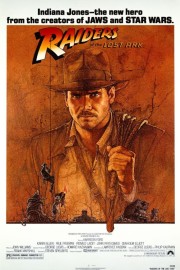Raiders of the Lost Ark
Sorry, George– I’m not calling this “Indiana Jones and the Raiders of the Lost Ark.” Sure, muck with the title of “Star Wars”– that one made sense. But don’t touch “Raiders.”
Thankfully, while George Lucas has been the creative force behind the Indiana Jones franchise for 30 years, developing the stories and treasures for Indy to hunt, there have always been two other important people involved with the series: director Steven Spielberg, and star Harrison Ford. Put those three together, and for eight years, the “Indiana Jones” series was unstoppable for action entertainment. (Whether 2008’s “Kingdom of the Crystal Skull” ruined the franchise for the future is open to debate.)
With their first entry is the series, 1981’s “Raiders of the Lost Ark,” the trio came out with guns blazing, and made one of the best adventure films of all-time. For Spielberg, it was a chance to show that his last film, the critically lambasted “1941,” was an aberration in what would be one of the greatest directorial careers in cinema history. For Lucas, it was an opportunity to exercise the creative freedom he had gained with the first two “Star Wars” films. And for Ford, it completed the rise to super-stardom his career took with Han Solo, and continued over the decades with not just the later “Indiana Jones” films but “The Fugitive,” “Air Force One,” “Patriot Games” and “Clear and Present Danger,” and many others.
The story well-known. In 1936, Indiana Jones is approached by the U.S. government to go after the Ark of the Covenant, the religious artifact that is thought to contain the pieces of the Ten Commandment tablets brought down by Moses. Before they begin their war against the rest of the world, the Nazis and Hitler are searching for the Ark in Egypt; legend has it that the Ark will give unimaginable power to an army that carries it. First, however, Jones must travel to Nepal to see an old flame (Marion Ravenwood, played by Karen Allen) who may have the key to finding the Ark.
From the moment Indy whips that gun out from the hand of an assassin in South America, “Raiders of the Lost Ark” hits the ground running with excitement. Yes, there’s the rolling ball and booby traps of the opening sequence, but when the story (by Lucas and Philip Kaufman, and a screenplay written by Lawrence Kasden) turns to the Ark, it sets the template for so many films after it. The suspense of the film comes from the race against the clock Indy and his friend, Sallah (John Rhys-Davies), face as the Nazis get closer to finding the Ark. But being an “Indiana Jones” film, things are never as simple as that, as one damn thing on top of the other happens, leading to a climax as natural as it is surprising.
Spielberg is at the peak of his form with this film. His approach is uncluttered with the sort of directorial flourishes that would become the bread and butter of the action genre. There’s no slow-motion or over-stylized atmosphere in Douglas Slocombe’s cinematography. No seizure-inducing “kineticism” in Michael Kahn’s editing. No ear-shattering music; just John Williams and his classic approach to film composing, complete with his famous “Raiders March.” And his use of special effects is subtle, not over-abundant to the point of numbing his audience. Action directors would’ve been good to study the film, although unfortunately for moviegoers, they watched the film, but didn’t learn much from Spielberg’s direction. Especially when you get to that classic desert chase where Indy takes a truck carrying the Ark, you see the inspired decision to go old-school with stunt work and effects. Of course, at the time, what was old-school now was still state-of-the-art then, although as we’ve seen in films from “Jurassic Park” to “Minority Report” to even “Saving Private Ryan,” Spielberg has just added a few more tools to the toolbox; his approach to action remains just as old-fashioned and rooted in the story and characters as it always has. That conviction in his directing style is part of why his return to this type of adventure with a filmmaking medium as new as performance-capture animation with “The Adventures of Tintin” is so exciting to long-time fans: even though he’s expanding his horizons artistically, one hopes to see the same sense of fun and adventure he brought to this wildly entertaining thrill ride. I’ll know whether he succeeded when I see the new film for myself later this week.










